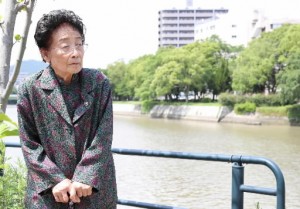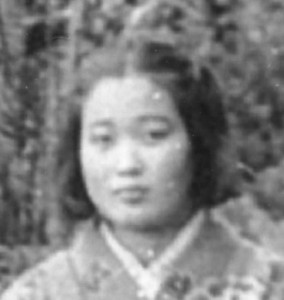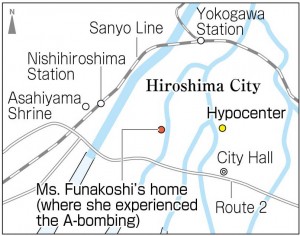Survivors’ Stories: Tomiko Funakoshi, 88, Saeki Ward, Hiroshima
Jul. 4, 2016
Desperate escape from an unfamiliar place
by Rie Nii, Staff Writer
Tomiko Funakoshi (née Mitsuda), 88, experienced the atomic bombing at the age of 18. She suffered symptoms of acute radiation sickness, such as hair loss, and was hospitalized about seven years after the bombing because of poor health, which included bloody diarrhea. The cause of all this was her exposure to the atomic bomb. While she managed to survive, she has continued to suffer from anemia.
When the city of Hiroshima was attacked with the atomic bomb, Ms. Funakoshi was a fourth-year student at Gion Girls’ High School (now AICJ High School). Her sister, Fumie Katayama, who was two years older, was married and lived in Tanaka-cho (now part of Naka Ward), and Ms. Funakoshi was living with the couple temporarily. But the home was marked for demolition in order to create a fire lane, and so they moved to Tenma-cho (now part of Nishi Ward and about 1 kilometer from the hypocenter) at the end of July 1945.
On the morning of August 6, while she was at home getting ready to go to Kabe-cho (now part of Asakita Ward) to work as a mobilized student, there was a sudden whitish-blue flash of light. Thinking that a bomb was dropped on the house, she shut her eyes and ducked down. After a while, feeling pressure on her chest, she opened her eyes and found herself buried up to her chest in fallen roof tiles.
Her sister, who had been in the kitchen, was safe, but Ms. Isobe, the elderly landlady who lived with them, was caught under the wreckage of the building. When they pulled her out, they saw a large wound to her head and her face was covered with blood. Ms. Funakoshi said, “Let’s run away,” but Ms. Isobe would not move, saying that she had to find her rice-rations book and savings passbook, so Ms. Funakoshi was forced to leave her behind when she fled.
The man who lived next door was naked and his skin was peeling away from his body except for where he apparently had been wearing a hat. His wife, who was next to him, was also naked except for the collar of a cotton kimono. The baby she held looked like a chunk of raw meat, all the skin having peeled away.
Because she had moved to the area only recently, she was a stranger and she fled with a wave of other survivors. After passing a railroad crossing in Koi-cho (now part of Nishi Ward), part of the Miyajima Line operated by the Hiroden Electric Railway, a woman living nearby gave a pair of shoes and a blouse to Ms. Funakoshi, who was in her underwear and bare feet.
Finally reaching Asahiyama Shrine, she tried mounting the stone steps but was unable to see them because black rain was now pouring down from the sky. Groping her way along, she slowly went up the steps. When the black rain stopped falling, at around 4 p.m., she walked back to her parents’ house in the village of Tomo (now part of Asaminami Ward).
Her parents’ home was crammed with relatives who had fled the catastrophe. When she lay down in a back room, she felt so fatigued that she was unable to move. Before long, her hair fell out.
After the war, Ms. Funakoshi was invited to be a teacher in the village of Toyama (now part of Asaminami Ward), where the home of her mother’s parents was located. After attending Mihara Women’s Normal School for a year, in the city of Mihara, she became a teacher at a junior high school in Toyama.
After a while, however, she became so ill that she was unable to lift her legs onto a classroom podium. She was then diagnosed with tuberculosis and admitted into a sanatorium for teachers in the village of Jigozen (now part of the city of Hatsukaichi). After a year, when her X-rays showed normal results, she was discharged from the sanatorium. Seiji Funakoshi, 86, who was visiting someone in the sanatorium while she was there, fell in love with her at first sight and married her in the spring of 1952.
In the summer of that year, Ms. Funakoshi suddenly came down with bloody diarrhea while in the city of Odawara in Kanagawa Prefecture because her husband was attending Tamagawa University (now located in the city of Machida in Tokyo). After two weeks in the hospital there, she moved to the Hiroshima Red Cross Hospital (now part of Naka Ward). Her doctor told her that she would die if she did not receive a blood transfusion, but she declined this advice, fearing the risk of hepatitis. Though the doctor said that her condition had been among the most serious in the hospital, she continued to survive and about a year later, she left the hospital.
While in the hospital, she learned that her mother-in-law had said to her husband, “Tomiko won’t be able to give birth because she experienced the atomic bombing. You should marry a healthy woman.” She had two daughters after she left the hospital, but she locked away the memories of the atomic bombing inside herself.
Ms. Funakoshi could not bear even thinking of her experience of the bombing. Her sister, who actively sought to hand down her experience of the atomic bombing to younger generations as an A-bomb survivor, passed away about ten years ago, and she decided, since she had lived this long, that it was time to talk about her experience, too. Last year she contributed her account to the Hiroshima National Peace Memorial Hall for the Atomic Bomb Victims, located in Naka Ward. She said, “Nuclear weapons will annihilate the human race. We must abolish them.”
Teenagers’ Impressions
Excessive greed will lead to war
Again and again, Ms. Funakoshi said, “We must not be greedy for gain. Excessive greed will lead to a nuclear war, and the human race will come to ruin.” Excessive greed could start a war and steal away innocent lives. I wonder if there’s no other choice except putting constraints on the use of nuclear weapons. If more countries would reject nuclear arms, then even the nuclear nations won’t resort to using their weapons. (Akane Sato, 13)
You have only one life
Ms. Funakoshi said, “You have only one life, so don’t behave recklessly.” When she was around my age, she saw many people die right in front of her, and I’m sure her shock was an unimaginable nightmare. I think she told us these things because she herself suffered from the atomic bombing. I was reminded of the importance of valuing life. (Kana Okino, 16)
Nuclear weapons could end human life
I said to Ms. Funakoshi, “What should young people do to help build a peaceful world?” Her only words were, “Abolish nuclear weapons.” Today, the power of nuclear weapons is incomparably destructive, and the world is surrounded by danger. Using nuclear weapons means that the human race could come to an end. With that in mind, I want to think about what I can do to help. (Nako Yoshimoto, 17)
(Originally published on July 4, 2016)
by Rie Nii, Staff Writer
Tomiko Funakoshi (née Mitsuda), 88, experienced the atomic bombing at the age of 18. She suffered symptoms of acute radiation sickness, such as hair loss, and was hospitalized about seven years after the bombing because of poor health, which included bloody diarrhea. The cause of all this was her exposure to the atomic bomb. While she managed to survive, she has continued to suffer from anemia.
When the city of Hiroshima was attacked with the atomic bomb, Ms. Funakoshi was a fourth-year student at Gion Girls’ High School (now AICJ High School). Her sister, Fumie Katayama, who was two years older, was married and lived in Tanaka-cho (now part of Naka Ward), and Ms. Funakoshi was living with the couple temporarily. But the home was marked for demolition in order to create a fire lane, and so they moved to Tenma-cho (now part of Nishi Ward and about 1 kilometer from the hypocenter) at the end of July 1945.
On the morning of August 6, while she was at home getting ready to go to Kabe-cho (now part of Asakita Ward) to work as a mobilized student, there was a sudden whitish-blue flash of light. Thinking that a bomb was dropped on the house, she shut her eyes and ducked down. After a while, feeling pressure on her chest, she opened her eyes and found herself buried up to her chest in fallen roof tiles.
Her sister, who had been in the kitchen, was safe, but Ms. Isobe, the elderly landlady who lived with them, was caught under the wreckage of the building. When they pulled her out, they saw a large wound to her head and her face was covered with blood. Ms. Funakoshi said, “Let’s run away,” but Ms. Isobe would not move, saying that she had to find her rice-rations book and savings passbook, so Ms. Funakoshi was forced to leave her behind when she fled.
The man who lived next door was naked and his skin was peeling away from his body except for where he apparently had been wearing a hat. His wife, who was next to him, was also naked except for the collar of a cotton kimono. The baby she held looked like a chunk of raw meat, all the skin having peeled away.
Because she had moved to the area only recently, she was a stranger and she fled with a wave of other survivors. After passing a railroad crossing in Koi-cho (now part of Nishi Ward), part of the Miyajima Line operated by the Hiroden Electric Railway, a woman living nearby gave a pair of shoes and a blouse to Ms. Funakoshi, who was in her underwear and bare feet.
Finally reaching Asahiyama Shrine, she tried mounting the stone steps but was unable to see them because black rain was now pouring down from the sky. Groping her way along, she slowly went up the steps. When the black rain stopped falling, at around 4 p.m., she walked back to her parents’ house in the village of Tomo (now part of Asaminami Ward).
Her parents’ home was crammed with relatives who had fled the catastrophe. When she lay down in a back room, she felt so fatigued that she was unable to move. Before long, her hair fell out.
After the war, Ms. Funakoshi was invited to be a teacher in the village of Toyama (now part of Asaminami Ward), where the home of her mother’s parents was located. After attending Mihara Women’s Normal School for a year, in the city of Mihara, she became a teacher at a junior high school in Toyama.
After a while, however, she became so ill that she was unable to lift her legs onto a classroom podium. She was then diagnosed with tuberculosis and admitted into a sanatorium for teachers in the village of Jigozen (now part of the city of Hatsukaichi). After a year, when her X-rays showed normal results, she was discharged from the sanatorium. Seiji Funakoshi, 86, who was visiting someone in the sanatorium while she was there, fell in love with her at first sight and married her in the spring of 1952.
In the summer of that year, Ms. Funakoshi suddenly came down with bloody diarrhea while in the city of Odawara in Kanagawa Prefecture because her husband was attending Tamagawa University (now located in the city of Machida in Tokyo). After two weeks in the hospital there, she moved to the Hiroshima Red Cross Hospital (now part of Naka Ward). Her doctor told her that she would die if she did not receive a blood transfusion, but she declined this advice, fearing the risk of hepatitis. Though the doctor said that her condition had been among the most serious in the hospital, she continued to survive and about a year later, she left the hospital.
While in the hospital, she learned that her mother-in-law had said to her husband, “Tomiko won’t be able to give birth because she experienced the atomic bombing. You should marry a healthy woman.” She had two daughters after she left the hospital, but she locked away the memories of the atomic bombing inside herself.
Ms. Funakoshi could not bear even thinking of her experience of the bombing. Her sister, who actively sought to hand down her experience of the atomic bombing to younger generations as an A-bomb survivor, passed away about ten years ago, and she decided, since she had lived this long, that it was time to talk about her experience, too. Last year she contributed her account to the Hiroshima National Peace Memorial Hall for the Atomic Bomb Victims, located in Naka Ward. She said, “Nuclear weapons will annihilate the human race. We must abolish them.”
Teenagers’ Impressions
Excessive greed will lead to war
Again and again, Ms. Funakoshi said, “We must not be greedy for gain. Excessive greed will lead to a nuclear war, and the human race will come to ruin.” Excessive greed could start a war and steal away innocent lives. I wonder if there’s no other choice except putting constraints on the use of nuclear weapons. If more countries would reject nuclear arms, then even the nuclear nations won’t resort to using their weapons. (Akane Sato, 13)
You have only one life
Ms. Funakoshi said, “You have only one life, so don’t behave recklessly.” When she was around my age, she saw many people die right in front of her, and I’m sure her shock was an unimaginable nightmare. I think she told us these things because she herself suffered from the atomic bombing. I was reminded of the importance of valuing life. (Kana Okino, 16)
Nuclear weapons could end human life
I said to Ms. Funakoshi, “What should young people do to help build a peaceful world?” Her only words were, “Abolish nuclear weapons.” Today, the power of nuclear weapons is incomparably destructive, and the world is surrounded by danger. Using nuclear weapons means that the human race could come to an end. With that in mind, I want to think about what I can do to help. (Nako Yoshimoto, 17)
(Originally published on July 4, 2016)










